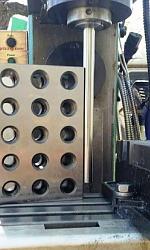Do you find yourself using less than optimum approaches to remove metal because you don't want to tram your mill in again afterwards? I know I did until I adopted this procedure that Keith Rucker uses instead of tramming his mill. He uses a cylindrical square directly against the quill of his mill to set it exactly square to the table (the objective of tramming) but those are really expensive.
I used a precision shaft chucked in the spindle (I think highly of Thompson QS precision shafting) and one of a pair of 2-4-6 blocks that I bought for this purpose (as well as other setup uses) and my mill was trammed better in 5 minutes than I had previously done with an indicator on a bar in the spindle. The 2-4-6 block is eased against the chucked shaft with a bright flashlight directed from behind and you can easily see .001" out of square like this, and this method when completed is close enough to perfectly square that a surfacing cutter leaves cross marks in the milled surface. Use a portion of the block where the surface is continuous and not interrupted by the holes in the block.
All in I think I've got less than $100 in this method as well as some more useful items for setup.



 LinkBack URL
LinkBack URL About LinkBacks
About LinkBacks


 Reply With Quote
Reply With Quote



Bookmarks